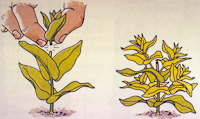 Most plants display a
process called apical dominance in which the bud at the
top of the stem (apex) sends a hormonal signal down to
buds at lower levels. This signal inhibits these buds
from breaking and growing. The further away from the
top, the lower the intensity of the signal. This results
in plants that have short branches near the top and
longer branches as you go down the stem.
Most plants display a
process called apical dominance in which the bud at the
top of the stem (apex) sends a hormonal signal down to
buds at lower levels. This signal inhibits these buds
from breaking and growing. The further away from the
top, the lower the intensity of the signal. This results
in plants that have short branches near the top and
longer branches as you go down the stem.
Annuals and
herbaceous perennials
that we grow in the landscape tend to flower at the tips
of branches. Therefore, the more branches on the plant,
the greater the number of desirable flowers for us to
see. By pinching off the apical (top) bud on the plant,
the side buds begin to grow resulting in a stocky, more
branched plant. This results in more places for flowers
to form. Generally, pinching is done in the spring to
allow time for the plants to develop the branching.
Traditionally,
petunias
and geraniums (Pelargoniums)
were pinched to avoid the long, stringy stems that did
not produce a lot of flowers. The newer "wave" petunias
have a very weak apical dominance and tend to branch
freely without being pinched.
In shrubs,
Rhododendrons
and azaleas are sometimes pinched to form a bushier
plant. Pine trees in Christmas tree plantations are
pinched in the early summer to produce thick, lush
foliage. This is great for Christmas trees but is not so
great for landscape plants. The process encourage such
thick foliage that it holds more moisture and makes the
plants more susceptible to fungal
needlecast diseases.
Pinching is not the same as
deadheading.



